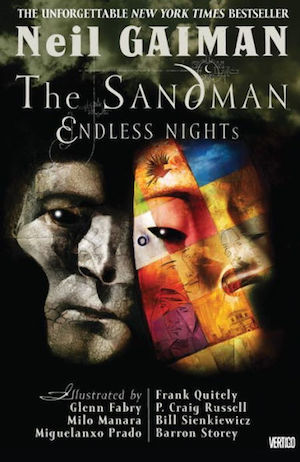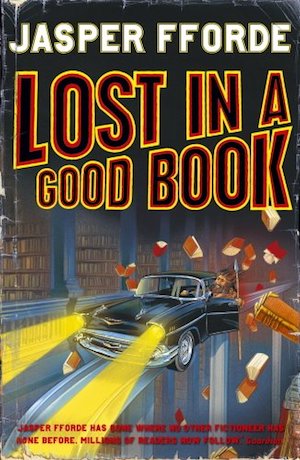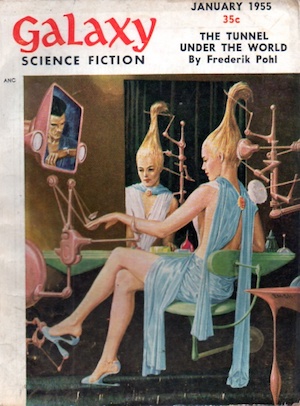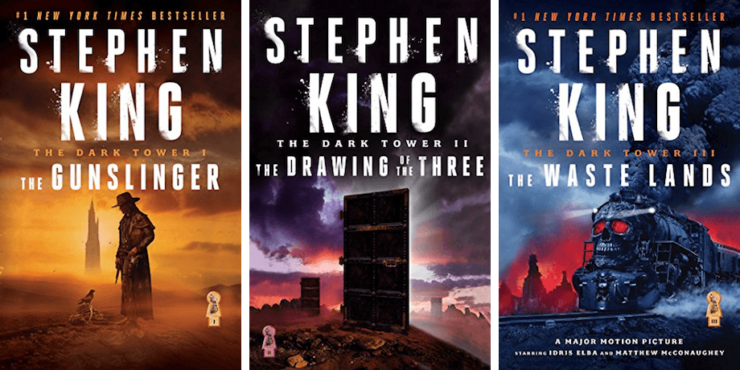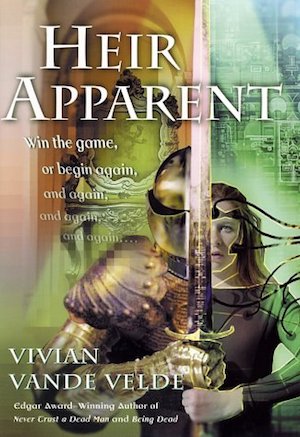The now-classic Groundhog Day flirts with (and breaks) the rules of multiple movie genres: romantic comedy, time travel narrative, small town dramedy, spiritual redemption tale—and it’s also given birth to an entire subgenre of its own. The “Groundhog Day episode” is a mainstay of many television series, and the plot even pops up in films, novels, and short fiction. It’s a fun way to play with established characters, putting your faves through the emotional wringer while trying to solve a murder or stop a crime. And it can be an equally effective tool for riffing on entire genre tropes; mixing in high school drama, slasher horror, or other well-worn genres can lead to some fascinating mashups. And in (almost) all cases, the protagonist stuck in the time loop comes out on the other side all the better.
We’ve compiled a list of our favorite Groundhog Day riffs and the most memorable time loops in SFF. Take a break from listening to “I Got You Babe” for the nth time and check out these 14 recursive tales.
[Note: some spoilers ahead!]
Farscape: “Back and Back and Back to the Future”
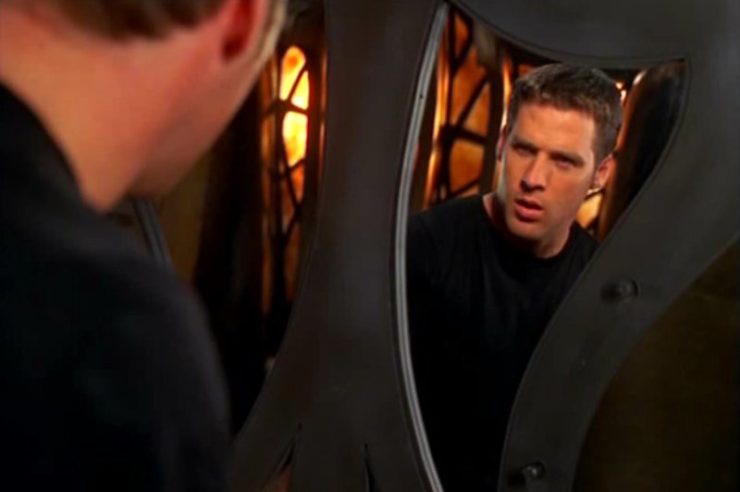
It takes guts to do a Groundhog Day episode at the start of your run, but that’s exactly what Farscape did in their fifth episode. When new guests appear on Moya, blood cousins of D’Argo’s species, John begins having flashes of the future where different sets of people wind up dead. He finds it difficult to explain to most of the crew members—they are still reticent to trust him as an odd, volatile species that they know nothing about—but eventually settles on trying to communicate this strange occurrence to Zhaan. From that point on, John finds himself trapped in a loop where he begins by telling Zhaan what he believes is wrong, then drops a precious glass mask that belongs to her, and afterwards fails to prevent the deaths of his shipmates. Eventually John learns that he’s suffering temporal dislocation as a result of the black hole weapon their guests have brought onto Moya without the crew’s knowledge. After a few runarounds with different permutations of the scenario, John finally figures out how to convince his friends of what’s happening, and they Starburst away before the black hole weapon can destabilize and kill them all. —Emmet Asher-Perrin
Happy Death Day
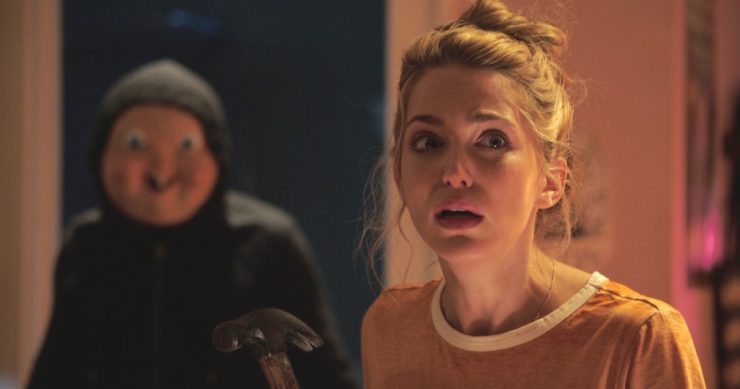
Blumhouse Productions’ 2017 Halloween offering has a pretty unbeatable premise: Groundhog Day crossed with a slasher film, in which co-ed Tree (short for Theresa) is endlessly chased and killed by a psycho with a knife wearing a nightmare-fodder cartoon baby mask on her birthday. Every time she gets murdered, she wakes up on her birthday again. Happy Death Day refreshes the time loop premise by making the archetype who would usually bite the dust early in the movie—that is, the clueless sorority girl—self-aware and active in her own fate; as she retains memories of the previous days, she’s able to begin anticipating the killer’s approach to try and evade her own murder. As Tree learns to pay attention to her sorority sisters and the sweet underclassman trying to help her stay alive, as she investigates red herrings and reconciles with estranged family on what is already an emotional bulldozer of a day, she slowly transforms herself into a Final Girl.
Now, the movie doesn’t quite deliver on its excellent trailer, as there’s too much bloat in the middle while Tree is still figuring out how to break free of her time loop and not enough subterfuge surrounding the identity of her killer. But lead actress Jessica Rote is a snarky, gutsy comic gem and should totally be cast in more trope-defying movies. While you’ll probably guess Happy Death Day’s ending a mile away, as we’ve learned from these types of stories, the fun is in the journey, not the destination. —Natalie Zutter
The Good Place

There’s no way to talk about this without spoilers for season one, so skip ahead if you need to!
In its first season, The Good Place trundled along disguised as a brilliant fish-out-of-water sitcom in which deceased human trashfire Eleanor Shellstrop is sent to “The Good Place” by mistake and has to pretend to belong. In the season finale, it pulled all the rugs out from everyone when Eleanor realized that “The Good Place” was actually “The Bad Place”—an afterlife of unending psychological torture. And froyo.
The second season blew the concept open, running through a montage of scenarios in which one of the four main characters figured the twist out within months, days, or even minutes of being introduced to the “Good” Place. Finally, in “Dance Dance Resolution,” they learn that they’ve gone through over 800 iterations of their life in The “Good” Place, and decide to team up with Michael, the demon who has been tormenting them. The show stops being a simple riff on a time loop story, and instead digs into the emotional underpinnings of Groundhog Day: Michael, formerly self-assured and happily evil, is going through one humdinger of an existential crisis. The second half of season 2 has focused on Michael’s quest to be “good”—all while trying to keep his boss from finding out. —Leah Schnelbach
The Vampire Diaries
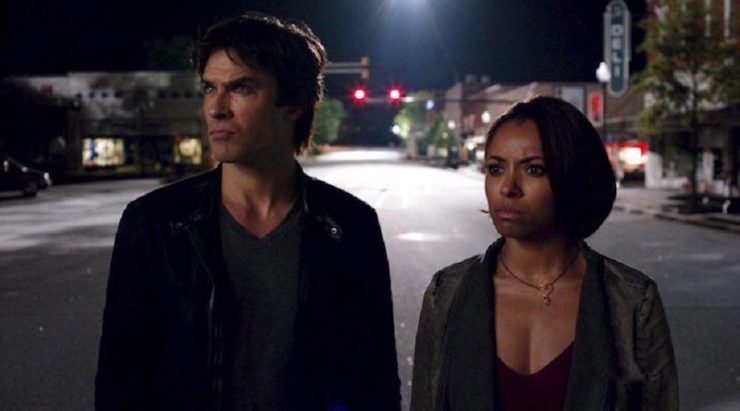
There are worse times to be stuck in than 1994. But there’s always a catch, right? And in The Vampire Diaries’ sixth season, the catch is that Bonnie Bennett (sans her magical powers) and Damon Salvatore (still a vampire) are trapped in a prison world that was meant to hold a really irritating serial killer. At first, reliving May 10, 1994 isn’t that bad: they camp out in the Salvatore house, the grocery store seems to restock itself, and Damon gets pretty decent at making waffles. (Why they’re there is just too much to get into; have you watched this show? Summarizing it in a way that makes sense is a highly specialized art form.) After four months, someone else fills in a clue on their crossword puzzle. When they meet this someone—Kai, played by Chris Wood (you may know him as Supergirl’s Mon-El)—he’s spiked the bourbon in the grocery store with toxic-to-vampires vervain, rendering Damon helpless. It’s all a big ploy to motivate Bonnie to get her magic back, and did I mention this show is convoluted? I shan’t get into the drama that getting out of the prison world entails, as we’d be here all day. This plotline subjected us to way too much of Kai’s murdery annoyingness, but at least it also gave Bonnie and Damon’s friendship a chance to develop further. He’s a semi-reformed jerk and she’s a witch who’s been put through the wringer and then some; 1994 is hardly the worst thing they’ve faced. —Molly Templeton
The Sandman: Endless Nights by Neil Gaiman and Dave McKean
Endless Nights is a collection of graphic vignettes about Neil Gaiman’s Endless, the seven siblings who are—in a sense—the building blocks of our universe. The final story of these is concerned with Destiny, its title eponymous with the title of the whole tome. In it, Destiny walks through his garden, his book chained to his wrist. The narrative addresses the reader in second person, and “you” are informed that Destiny’s book contains between its pages every moment of your life, and every moment of every other life. Everything you know and do not know. Everything you believe and do not believe. Every other person who will live and die in this universe. The story tells you that one day the book will be over and no one knows what will come after it is finished. But Destiny turns the page of his book… and walks through the garden, his book chained to his wrist… —EAP
Lost in a Good Book by Jasper Fforde
In an alternate 1985 where computers haven’t been invented but literature is protected at Fort Knox and time travel is de rigeur, one of the cruelest and most unusual forms of punishment is Closed Loop Temporal Field Containment: Pop a criminal into the same eight-minute time loop on repeat for anywhere from five to twenty years, and by the time they’re freed, they won’t know heads or tails enough to want to return to that life. Literary detective Thursday Next acknowledges the brutality of this warped form of justice, yet its true effect doesn’t really sink in until she gets in the middle of a fight between the ChronoGuard and her target:
I yelled, “NO!” and pulled out my gun and aimed it at the man who held Billden.
I yelled, “NO!” and pulled out my gun and aimed it at the man who held Billden.
I yelled, “NO!” and pulled out my gun and aimed it at the man who held Billden.
I yelled, “NO!” and pulled out my gun and aimed it at the man who held Billden.
And so forth for about a page until she suddenly comes to, disarmed and disoriented. In the case of Jasper Fforde’s novel, the time loop is an obstacle, not an aid, to Thursday ensuring that her husband is born, instead of erased from this timeline. But it does change her outlook on the punishment itself. —NZ
Stargate SG-1, “Window of Opportunity”

On a mission to a planet experiencing strange solar activity, the SG-1 team has a run-in with an archaeologist who seems a tad unbalanced. Following a geomagnetic disturbance, Jack O’Neill and Teal’c both find themselves trapped in a time loop of this day over and over. They attempt to explain this to Daniel Jackson, Sam Carter, and General Hammond with varying levels of success as the loop plays out, but fail to prevent numerous iterations over the course of many months. Because Daniel (their resident linguist, archaeologist, and anthropologist) is not a part of the time loop, Jack and Teal’c are forced to learn and memorize the alien language on the solar-wobbly planet in an effort to break the loop. Daniel also points out that a time loop allows them to do what they want without consequences, however, which leads to a series of antics on their part—they play golf through the Stargate, Jack rides a bike through the SGC, they both learn to juggle. Eventually they find out that the archaeologist they encountered on their mission is attempting to use incomplete time travel technology of the Ancients, trying to get more time with his dead wife. Jack, who lost his son some years back, appeals to the man to get him to shut down the loop. —EAP
“The Tunnel Under the World” by Frederik Pohl
In Pohl’s disturbing short story (and the only entry on this list that actually predates Groundhog Day), Guy Burckhardt wakes up on June 15 screaming from a nightmare of an explosion. As he goes about his normal day in Tylerton, he can’t shake the oddness of certain details being off, primarily all of life’s little annoyances—a stuck door latch, a loose floorboard—suddenly smoothed over. Then there’s the matter of all of the goods and services being hawked at him, from a blaring truck advertising freezers at 6 a.m., to the newspaper stand guy basically paying him to try a new brand of cigarettes, to the most unpleasant, jingle-laden elevator ride to his job. But weirdest of all is when he goes to sleep, and wakes up the next morning—on June 15, except he’s the only one who realizes he’s living the same day, albeit with a whole new set of carefully curated advertisements, over again. As Guy struggles to escape this seeming time loop, he discovers the true purpose of Tylerton and his own fate. —NZ
The Dark Tower Series by Stephen King
Though it took some time to reveal the truth (an entire series of books, when all was said and done), the Dark Tower series is perhaps the greatest Groundhog Day story arc in all of genre fiction—though it’s more like a Groundhog Quest than one simple day repeating. The tale follows the Gunslinger Roland on his journey to the Dark Tower and the people he brings with him… and often loses along the way. But after who-knows-how-many cycles of this tale, Roland finally learns that he has reached the Dark Tower before, many times, and that he keeps having to repeat this quest, presumably in order to get it right. At the end of The Dark Tower VII, Roland is sent back to the beginning yet again, but with something that he lacked in his previous journeys: the Horn of Eld. Stephen King himself said that the Dark Tower film of 2017 was meant to be Roland’s final run to the Tower, and true to the book series finale, Idris Elba’s Roland has the Horn of Eld when he begins his journey. With the end of the film seeing Roland and Jake head off on a brand-new adventure, it would seem that the cycle is finally broken, 35 years after the first book appeared on shelves. —EAP
The X-Files, “Monday”
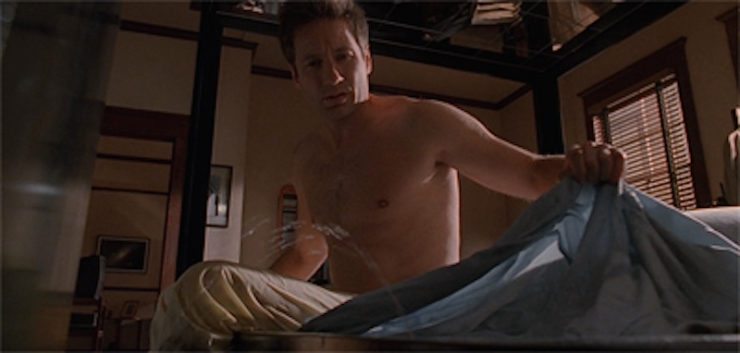
The episode opens with the shocking image of Mulder bleeding out from a gunshot wound. He and Scully have been caught in a bank robbery, and when Scully tries to reason with the gunman, he reveals a homemade bomb, and detonates it rather than surrendering to the police. And thus the show ended in its sixth season without ever solving… oh, wait. In the next scene Mulder wakes up to discover that his waterbed has sprung a leak (because of course Mulder has a waterbed) and for a few minutes it seems like the bank robbery was a nightmare—until he ends up back in the bank with Scully, and the same bomber walks in. It soon becomes clear to the audience that the agents are trapped in a loop that always ends in the same horrific explosion. It also becomes clear that the only one aware of what’s happening is the bomber’s girlfriend, Pam, at one point telling Mulder that she’s spoken to him over fifty times—and of course she’s the only one who can break the cycle.
The episode is a perfect riff on Groundhog Day because it plays with the idea of time itself getting stuck. This isn’t just Mulder or Pam living this day over and over, it’s every single person in the bank, and everyone affected by their deaths. Plus it makes for a particularly great X-File because it implies that giant, horrifying mysteries are unfolding around Mulder and Scully all the time, without their knowledge. How long have they been trapped in this loop? How many other loops have they stumbled into and escaped, without ever knowing it? —LS
Supernatural, “Mystery Spot”
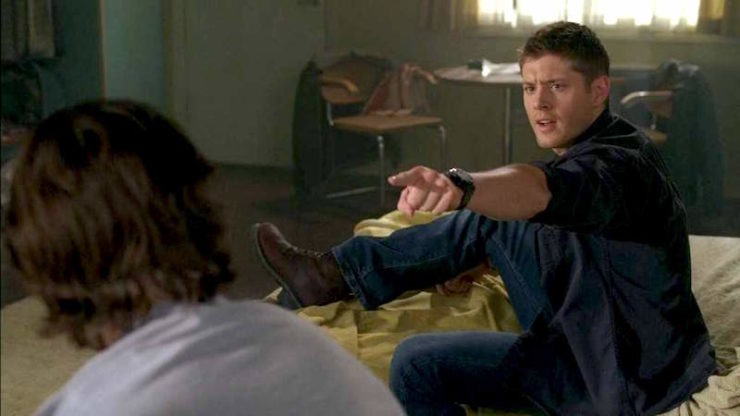
Poor Sam Winchester can’t catch a break. His brother Dean is already running on borrowed time (after signing over his soul to a demon to bring Sam back from the dead), with only a year left to live. Then one day Dean bites the dust ahead of schedule—but Sam wakes up to the exact same day all over again. Except this time he tries to change things, and Dean just dies a different way. And then he wakes up to the same day, and Dean dies again. And again. What’s worse, every morning Sam wakes up to Asia’s “Heat of the Moment,” which Dean dances along to vigorously. It’s a very peculiar version of hell, which Sam eventually learns is being run by a Trickster (who is later revealed to be the archangel Gabriel… yeah, it’s a long story) he and his brother had a run-in with a year ago. When Sam commands that they are released from the time loop, Dean dies again, but this time he stays dead and leaves his little brother cradling his body, whispering “I’m supposed to wake up…” Sam goes a bit dark-side trying to hunt down the Trickster and force him to fix this rotten timeline. The Trickster later explains that in a way, he’s trying to help; he wants Sam to learn how to cope without his big brother. But it undoubtedly leaves little Sammy scarred after countless days watching his brother get murdered in increasingly creative (though sometimes hilarious) ways. —EAP
Before I Fall by Lauren Oliver
Before Tree was outwitting a serial killer in Happy Death Day, another vapid bitch was confronting her own mortality in a time loop: Oliver’s 2010 YA novel has beta mean girl Sam reliving “Cupid Day” (a.k.a. February 12) over and over after her first go-round ends with her dying in a grisly car accident driving with queen bee Lindsay. At first thinking that she’s been granted a second chance without strings, Sam soon comes to realize that the only reason she hasn’t passed on is because she must change something about her fate—not her death, but someone else’s. Playing out different iterations of Cupid Day also allows Sam to grapple with the stages of grief: denial that the day will end her life; anger at Lindsay for bullying her before she joined their clique, spurring her on to hang out with other students she had written off; bargaining to save her own life; depression, which manifests in uncharacteristic recklessness; and, finally, acceptance. —NZ
Doctor Who, “Heaven Sent”
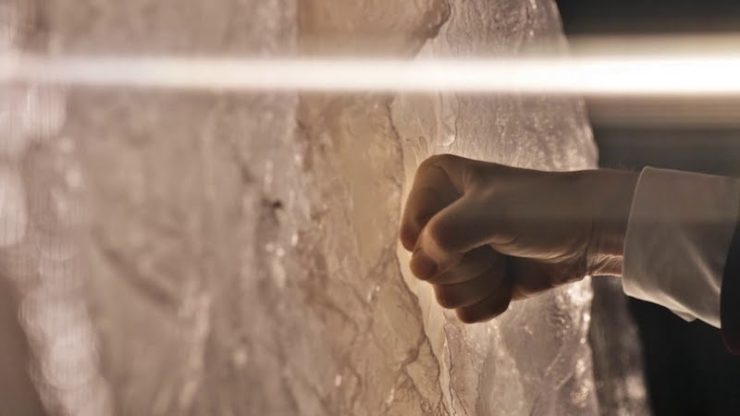
Doctor Who takes on this plot by refusing to let you in on the time loop secret during your first go-round. Following Clara Oswald’s seeming death, the Doctor finds himself in an empty castle where a mysterious creature known as the Veil stalks him as he tries to makes sense of the place. Clues in the castle direct him to room 12, where there is a wall of Azbantium, a substance 400 times harder than diamonds. It is eventually revealed that the Doctor has left a message for himself in this maze; the word “bird” drawn in the sand next to the teleportation chamber he arrived in, a reference to the Brothers Grimm tale “The Shepherd Boy,” where a bird wears down a mountain with its beak. The Doctor keeps dying after being touched by the Veil, only to reconstitute himself via the teleportation chamber, make his way back to room 12, and continue punching his way through the Azbantium wall over the course of several billion years. After all that time, he breaks through the wall and finally emerges on Gallifrey, having taken “the long way around” to find his way home. —EAP
Heir Apparent by Vivian Vande Velde
After marrying virtual reality with Dungeons & Dragons-esque fantasy in User Unfriendly, Vivian Vande Velde throws in a dash of video game commentary in this 2002 book set in the same universe and starring Giannine, one of the members of the prior book’s Rasmussem, Inc. campaign. This time, she’s been gifted a certificate to try out a single-player VR experience at one of Rasmussem’s gaming centers, instead of in the comfort of her own basement. In the game Heir Apparent, she is the illegitimate heir of a dead king, who has left her the throne over her three half-brothers. As Janine de St. Jehan, she must survive three days of game time to make it to her coronation. Giannine promptly starts the game and gets cut down.
Heir Apparent is a cheeky riff on video games with infinite lives, where the player must retread the same digital ground over and over, learning the quirks of cliff jumps or nabbing power-ups, where death is simply one step backward. Until, that is, a well-meaning group of “concerned citizens” breaks into the Rasmussem center and destroys the game’s failsafe… meaning that Giannine, neurally hooked up to the game, will suffer brain damage if she disconnects or if she doesn’t solve the game quickly enough. Suddenly, she doesn’t have the safety net of dying every time she crosses paths with a werewolf prince or fails to recite a poem that fails to satisfy the the saint statue guarding a powerful ring.
The definition of insanity is doing the same thing over and over again expecting a different outcome. In that case, you could call Giannine and her fellow gamers insane—until, that is, they hit upon that one little change that restores their sanity. While Giannine’s time loop doesn’t alter her character as drastically as Phil Connors’ or even Tree’s, Heir Apparent still lets her play out real-life frustrations—namely, her strained relationship with her father—in a virtual landscape and work toward mending her actual existence. —NZ
***
Time loop stories are the gift that keep on giving (and giving, and giving…) and since we first published this list there are even more to love—including Russian Doll and Palm Springs. Which are your favorites?
Originally published in February 2018.











